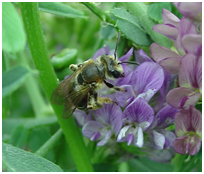| Pollinator Behavior and Gene Flow |

|

Linking pollinator foraging behavior to gene flow
Many wild plant species and most fruits and vegetables, some forage and oil producing crops require insects for pollination and seed production. Insect pollinators transfer pollen as they move from flower to flower. They move genes during this process which can lead to the escape of genetically engineered (GE) genes and create adventitious presence (unwanted gene flow), for example when they move from a genetically engineered (GE) to a conventional or organic field. Genetically engineered genes may also move to feral or wild populations. A better understanding of the relationships between pollinator foraging behavior and the potential for pollen dispersal and gene flow would not only improve predictions of gene flow risk (movement of pollen resulting in a mature seed) in insect-pollinated plants but it could guide the development of pollinator management strategies to reduce the risk of transgene escape. Reduced gene flow would facilitate the coexistence of different markets and limit the potential for introgression of transgenes into wild or feral populations.
We first examined the potential differential impact of distinct pollinator species on pollen dispersal and gene flow in the Rocky Mountain columbine (Aquilegia coerulea). This system was selected because bumblebees and hawkmoths could be contrasted, with bees visiting the plants mostly during the day and hawkmoths at dusk. We showed that distinct pollinators can differentially affect the outcrossing rate of plants (Brunet and Sweet 2006, Evolution) and, using genetic markers, that these different pollinators may differentially move pollen long distances (Brunet and Holmquist 2009, Molecular Ecology).

To examine the potential impact of the landscape on gene flow, we used alfalfa (Medicago sativa). Honey bees and leaf cutting bees are managed pollinators of alfalfa in seed production fields and bumble bees are used for alfalfa breeding. We demonstrated how features of the agricultural landscape, for eg. plant density, may differentially affect gene flow for distinct bee species (Brunet and Stewart 2010, Psyche: A Journal of Entomology). We described the conceptual framework that links pollinator behavior to gene flow (Brunet, 2018; Proceedings for the 2018 Winter Seed School Conference, WASGA) and identified some pollinator foraging behaviors that affect gene flow risk (Brunet et al. 2019, Plos One). We examined the impact of pollen viability on gene flow risk for conventional and genetically engineered alfalfa cultivars (Brunet et al., 2019; Plant Biology). We modified a seedling phenotypic assay to identify glyphosate resistance in different alfalfa varieties (Dieterich Mabin et al. 2019, Proceedings for the Winter Seed School Conference, WASGA. A layman description of this research can be found in Brunet, 2018, Scientia Global, https://www.scientia.global/dr-johanne-brunet-buzzing-blooming-bee-flower-interactions-in-crop-production.
More recently, we examined the role of pollinators and other factors besides distance between fields on the probability of gene flow in alfalfa seed production fields (Kesoju et al. 2021, Plos One).
We also examined and compared two bee species, the alfalfa leafcutting bee (Medicago sativa) and the common eastern bumble bee (Bombus impatiens) in their the probability of moving pollen (pollen dispersal) along successive flowers visited and distances traveled during their foraging bouts (Santa Martinez et al. 2021 AJB). We used plants transformed with the GUS gene expressed in their pollen for these experiments.
We compared three bee species, the two above and the European honey bee (Apis mellifera) in their ability to move genetically modified alleles as they visit successive flowers and traveled cumulative distances during their foraging bouts (Fragoso et al. 2022 preprint and submitted). We used the glyphosate resistance gene in these experiments. We found that bumble bees were most at risk of moving GM alleles the furthest, followed by honey bees, and least leafcutting bees. Results of this study support what has been previously observed in seed production fields or other field experiments examining gene flow in alfalfa fields, suggesting the behavior of bees at the foraging bout level can help explain gene flow at the landscape level.
